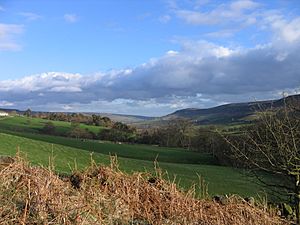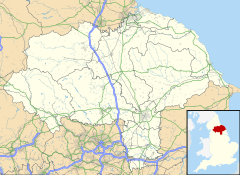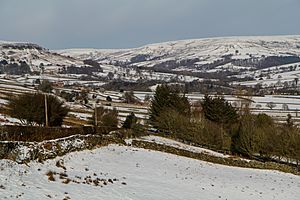Farndale facts for kids
Quick facts for kids Farndale |
|
|---|---|
 Farndale |
|
| Population | 207 (2011 census) |
| OS grid reference | SE673952 |
| Civil parish |
|
| District |
|
| Shire county | |
| Region | |
| Country | England |
| Sovereign state | United Kingdom |
| Post town | YORK |
| Postcode district | YO62 7 |
| Dialling code | 01751 |
| Police | North Yorkshire |
| Fire | North Yorkshire |
| Ambulance | Yorkshire |
| EU Parliament | Yorkshire and the Humber |
| UK Parliament |
|
Farndale is a beautiful valley in North Yorkshire, England. It is famous for its amazing display of wild daffodils that bloom every spring. These flowers grow along a 7-mile stretch of the River Dove. Farndale is located inside the North York Moors National Park. It is about 11 miles north of Kirkbymoorside, which is the closest town.
Farndale is made up of a few small communities spread out across the valley. In 2011, about 207 people lived here. By 2015, this number was estimated to be around 180. The two main areas, Farndale East and Farndale West, joined together in 2018 to form one parish.
This valley is a quiet farming area with traditional Yorkshire dry stone walls. These walls are built without using any mortar. Farndale is very popular with walkers, especially around Easter. This is when the famous wild daffodils bloom along the River Dove. To protect these special flowers, most of Farndale north of Lowna became a Local Nature Reserve in 1955.
Farndale has two small villages, called hamlets. Church Houses is at the top of the valley. Low Mill is further down and is a popular spot for visitors during daffodil season. This is where the famous daffodil walk starts. The walk ends at High Mill, which is a group of houses near Church Houses.
Every year, the Farndale Agricultural Show takes place on the last Monday of August. It is a very popular local event. The 100th show was held in 2006.
Contents
What's in a Name? The Meaning of Farndale
The name Farndale has an interesting history. It is made up of two parts: "Farn" and "Dale." Experts are not completely sure where "Farn" comes from, but there are a few ideas.
- It might come from an old Celtic word, "Faren," which means beautiful.
- Another idea is that it comes from the Scandinavian word "FæN," meaning sheep.
- It could also be from the Old English word "Fearn," which means fern or a ferny place.
- Finally, it might come from the Gaelic word "Feàrna," meaning alder tree. There are many alder trees in Farndale.
The second part, "Dale," most likely means valley. This could be from the Scandinavian word "Dalr" or the Anglian word "Dæl." It might also come from the Gaelic word "Dail," which means a flat field by a river.
The name of the River Dove, which flows through Farndale, probably comes from an old word meaning black or dark. This could be from the Old British word "Dubo" or the Gaelic word "Dubh." So, the river's name might mean Black River.
Exploring Farndale's Geography
Farndale is a valley located within the North York Moors National Park. It is surrounded by some of England's wildest open land, called moorland. To the west of Farndale is Bransdale, and to the east is Rosedale. To the north, you'll find Westerdale.
High points around Farndale include Blakey Ridge, which is over 400 meters (about 1,300 feet) above sea level. To the northwest, Cockayne Ridge reaches up to 454 meters (about 1,490 feet). This makes it one of the highest spots in the North York Moors.
The River Dove starts on Westerdale Moor, north of Farndale. It then flows south-east through Farndale past Church Houses. From there, it turns south and winds past Low Mill to Lowna. The river continues its journey past Hutton-le-Hole and Kirkbymoorside. Finally, it joins the River Rye in the Vale of Pickering near the village of Salton.
Several smaller streams join the River Dove in Farndale. Two of these streams, Blakey Gill and West Gill, give the valley a unique shape. Blakey Gill is near Church Houses, and West Gill is near Low Mill.
Protecting Farndale's Wild Daffodils
Most of Farndale is part of the Farndale Local Nature Reserve. This special area was created in 1955 to protect the famous wild daffodils. These daffodils are what the valley is best known for. The Local Nature Reserve is also part of a larger area called a Site of Special Scientific Interest, which covers about 157 hectares (about 388 acres).
Every spring, over 40,000 people visit Farndale to walk along the River Dove and see the daffodils. The wild daffodils in the valley have shorter stems than the ones you might see in gardens. People believe that monks planted these daffodils many centuries ago. In Farndale, these daffodils are also known as Lent Lilies. They usually appear around the time of Lent.
Walking the Long Distance Footpaths
Around the northern part of Farndale, you can find the old track of the Rosedale Ironstone Railway. This old railway line is now part of three famous Long Distance Footpaths. These are:
- Wainwright's Coast to Coast Walk
- The Lyke Wake Walk
- The Esk Valley Walk
These paths offer amazing views and a chance to explore the beautiful moorland.
How Farndale is Governed
Farndale has a long history of how it has been managed. In the past, it was split into different areas. Over time, these areas were combined. Until 2018, Farndale East and Farndale West had separate local groups that looked after their areas.
In April 2018, a single Farndale Parish Council was formed. This council now represents all the people living in Farndale. It works to make decisions and look after the interests of everyone in the valley.
Above the Parish Council, there are two other levels of local government. The first is the Ryedale District Council. The next level is the North Yorkshire County Council. Farndale has always been part of the historic North Riding of Yorkshire.
For national government, Farndale is part of the Thirsk and Malton area for the UK Parliament.




